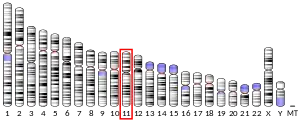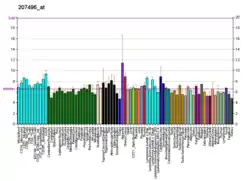MS4A2
High affinity immunoglobulin epsilon receptor subunit beta is a protein that in humans is encoded by the MS4A2 gene.[5][6]
Function
The allergic response involves the binding of allergen to receptor-bound IgE followed by cell activation and the release of mediators responsible for the manifestations of allergy. The IgE-receptor, a tetramer composed of an alpha, beta, and 2 disulfide-linked gamma chains, is found on the surface of mast cells and basophils. This gene encodes the beta subunit of the high affinity IgE receptor which is a member of the membrane-spanning 4A gene family. Members of this nascent protein family are characterized by common structural features and similar intron/exon splice boundaries and display unique expression patterns among hematopoietic cells and nonlymphoid tissues. This family member is localized to 11q12, among a cluster of family members.[6]
See also
References
- GRCh38: Ensembl release 89: ENSG00000149534 - Ensembl, May 2017
- GRCm38: Ensembl release 89: ENSMUSG00000024680 - Ensembl, May 2017
- "Human PubMed Reference:". National Center for Biotechnology Information, U.S. National Library of Medicine.
- "Mouse PubMed Reference:". National Center for Biotechnology Information, U.S. National Library of Medicine.
- Maekawa K, Imagawa N, Tanaka Y, Harada S (Aug 1992). "Determination of the sequence coding for the beta subunit of the human high-affinity IgE receptor". FEBS Lett. 302 (2): 161–5. doi:10.1016/0014-5793(92)80430-O. PMID 1386024. S2CID 44791683.
- "Entrez Gene: MS4A2 membrane-spanning 4-domains, subfamily A, member 2 (Fc fragment of IgE, high affinity I, receptor for; beta polypeptide)".
Further reading
- Jouvin MH, Numerof RP, Kinet JP (1995). "Signal transduction through the conserved motifs of the high affinity IgE receptor Fc epsilon RI". Semin. Immunol. 7 (1): 29–35. doi:10.1016/1044-5323(95)90005-5. PMID 7612892.
- Wilson BS, Pfeiffer JR, Oliver JM (2003). "FcepsilonRI signaling observed from the inside of the mast cell membrane". Mol. Immunol. 38 (16–18): 1259–68. doi:10.1016/S0161-5890(02)00073-1. PMID 12217393.
- Kraft S, Rana S, Jouvin MH, Kinet JP (2004). "The role of the FcepsilonRI beta-chain in allergic diseases". Int. Arch. Allergy Immunol. 135 (1): 62–72. doi:10.1159/000080231. PMID 15316148. S2CID 83898946.
- Bieber T, de la Salle H, Wollenberg A, et al. (1992). "Human epidermal Langerhans cells express the high affinity receptor for immunoglobulin E (Fc epsilon RI)". J. Exp. Med. 175 (5): 1285–90. doi:10.1084/jem.175.5.1285. PMC 2119213. PMID 1533242.
- Küster H, Zhang L, Brini AT, et al. (1992). "The gene and cDNA for the human high affinity immunoglobulin E receptor beta chain and expression of the complete human receptor". J. Biol. Chem. 267 (18): 12782–7. PMID 1535625.
- Le Coniat M, Kinet JP, Berger R (1990). "The human genes for the alpha and gamma subunits of the mast cell receptor for immunoglobulin E are located on human chromosome band 1q23". Immunogenetics. 32 (3): 183–6. doi:10.1007/BF02114971. PMID 2146219. S2CID 23874749.
- Tedder TF, Streuli M, Schlossman SF, Saito H (1988). "Isolation and structure of a cDNA encoding the B1 (CD20) cell-surface antigen of human B lymphocytes". Proc. Natl. Acad. Sci. U.S.A. 85 (1): 208–12. doi:10.1073/pnas.85.1.208. PMC 279513. PMID 2448768.
- Paolini R, Renard V, Vivier E, et al. (1995). "Different roles for the Fc epsilon RI gamma chain as a function of the receptor context". J. Exp. Med. 181 (1): 247–55. doi:10.1084/jem.181.1.247. PMC 2191817. PMID 7528770.
- Shirakawa T, Li A, Dubowitz M, et al. (1994). "Association between atopy and variants of the beta subunit of the high-affinity immunoglobulin E receptor". Nat. Genet. 7 (2): 125–9. doi:10.1038/ng0694-125. PMID 7920628. S2CID 24026689.
- Kihara H, Siraganian RP (1994). "Src homology 2 domains of Syk and Lyn bind to tyrosine-phosphorylated subunits of the high affinity IgE receptor". J. Biol. Chem. 269 (35): 22427–32. PMID 8071371.
- Sandford AJ, Shirakawa T, Moffatt MF, et al. (1993). "Localisation of atopy and beta subunit of high-affinity IgE receptor (Fc epsilon RI) on chromosome 11q". Lancet. 341 (8841): 332–4. doi:10.1016/0140-6736(93)90136-5. PMID 8094113. S2CID 54428682.
- Szepetowski P, Gaudray P (1994). "FCER1B, a candidate gene for atopy, is located in 11q13 between CD20 and TCN1". Genomics. 19 (2): 399–400. doi:10.1006/geno.1994.1083. PMID 8188278.
- Daniels SE, Bhattacharrya S, James A, et al. (1996). "A genome-wide search for quantitative trait loci underlying asthma". Nature. 383 (6597): 247–50. doi:10.1038/383247a0. PMID 8805698. S2CID 22256638.
- Hill MR, Cookson WO (1997). "A new variant of the beta subunit of the high-affinity receptor for immunoglobulin E (Fc epsilon RI-beta E237G): associations with measures of atopy and bronchial hyper-responsiveness". Hum. Mol. Genet. 5 (7): 959–62. doi:10.1093/hmg/5.7.959. PMID 8817330.
- Shirakawa T, Mao XQ, Sasaki S, et al. (1997). "Association between atopic asthma and a coding variant of Fc epsilon RI beta in a Japanese population". Hum. Mol. Genet. 5 (8): 1129–30. doi:10.1093/hmg/5.8.1129. PMID 8842731.
- Shirakawa T, Mao XQ, Sasaki S, et al. (1997). "Association between atopic asthma and a coding variant of Fc epsilon RI beta in a Japanese population". Hum. Mol. Genet. 5 (12): 2068. PMID 8968765.
- Hendricks-Taylor LR, Motto DG, Zhang J, et al. (1997). "SLP-76 is a substrate of the high affinity IgE receptor-stimulated protein tyrosine kinases in rat basophilic leukemia cells". J. Biol. Chem. 272 (2): 1363–7. doi:10.1074/jbc.272.2.1363. PMID 8995445.
- Kanzaki M, Lindorfer MA, Garrison JC, Kojima I (1997). "Activation of the calcium-permeable cation channel CD20 by alpha subunits of the Gi protein". J. Biol. Chem. 272 (23): 14733–9. doi:10.1074/jbc.272.23.14733. PMID 9169438.
This article incorporates text from the United States National Library of Medicine, which is in the public domain.





